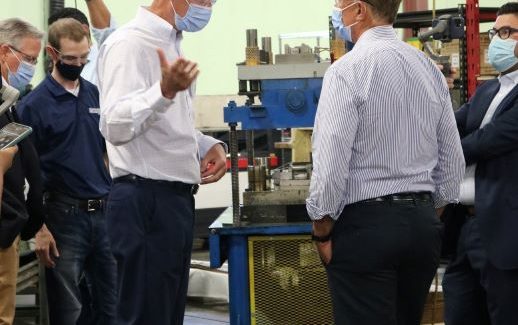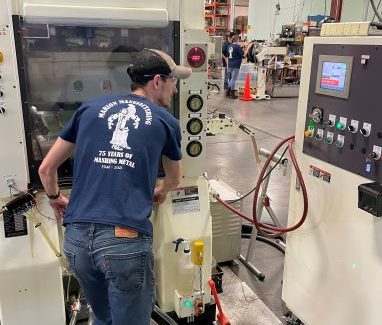Communicate, Diversify and Be Creative
There is a bright side to the challenges machine shops are dealing with. Get ahead of the issues and the positives in the manufacturing economy will see you to the other side. The experiences of a die stamping company in Connecticut may sound familiar; learn how their pro-active measures are making a difference.
Posted: October 12, 2021
EDITOR’S FORUM
In August, Marion Manufacturing Co. achieved a milestone and celebrated 75 years in business. Based in Cheshire, Conn., the progressive die stamper with a worldwide customer base, hosted Connecticut Gov. Ned Lamont, and received an award from the Precision Metalforming Association, among other activities at an open house celebration.
Many machine shops such as Marion Manufacturing find themselves in a good spot, but things are challenging out there. While manufacturing production forecasts by leading manufacturing and supply chain trade associations and economic groups find the sector is doing well and is predicted to continue to do so, supply chain bottlenecks and access to raw materials continue to cause snags.
The healthy outlook is backed by the numbers. According to the Federal Reserve, industrial production increased 0.9 percent in July after moving up 0.2 percent from June. In July, manufacturing output rose 1.4 percent, with nearly half of the gain in factory output attributable to a jump of 11.2 percent for motor vehicles and parts as several auto manufacturers canceled or scaled back the industry’s typical plant shutdowns that take place each July.
The Institute for Supply Management’s (ISM) August Manufacturing PMI was 59.9 percent, an increase of 0.4 percentage points from the July reading of 59.5 percent. The number represented the 15th consecutive month of growth in the manufacturing sector. A PMI above 43.1 percent, over a period of time, generally indicates an expansion of the overall economy, according to ISM. Fabricated metal products ranked No. 2 among the six largest and strongest manufacturing sectors, which registered moderate to strong growth.
In the Precision Metalforming Association’s Business Conditions Report for August, 29 percent of metal forming companies forecasted an increase in economic activity in the next three months (decreasing from 36 percent in July); 57 percent predicted no changes (compared to 55 percent in July); and 14 percent anticipated a decline in activity (increasing from 9 percent in July). What’s more, 64 percent of respondents reported an increase in lead times, up from 63 percent in July. The numbers are based on a sampling of 115 metal forming companies in the United States and Canada.
GET AHEAD OF THE CHALLENGES TO REMAIN COMPETITIVE
In much the same situation as their peers, Marion Manufacturing’s leadership has been planning months in advance (six to nine months out) regarding lead times because accessing raw materials is challenging. Price escalations are another concern and the company’s leadership has come to the realization that it is not about price right now; but whether you can secure material. “We have two people full time just working in the material market,” said Marion Manufacturing Co. President Doug Johnson. Marion Manufacturing serves the medical, telecommunications and electronics industries, among others.
To remain on top of things, the company’s staff is in constant communication with customers and suppliers, coming up with ways to work around supply chain hiccups, as well as exploring ways to add value to their services. Marion Manufacturing added laser cutting and engraving services during the last year, which helped attract new business.
On the production end, the company’s equipment assists in putting out parts faster, with one press running up to 1,000 strokes per minute — as long as the company has material. “We have adapted a bit to quicker change overs and are trying to stage things a bit differently than we would have pre-pandemic,” Johnson says. “We are lining things up differently.”
Marion Manufacturing is also planning purchases of new equipment to support growth efforts, including a press brake and a larger laser than they are currently using. “At the end of the day, the No. 1 goal for us is: what do we need to do to help our customers get their products to the market faster?” Johnson said. “What value-added services can we add that will help us do that?”
Like their peers, Johnson said the company is also focused on attracting and training the next generation of its workforce, and currently has four apprentices in the tool room who are less than 25 years old. “We are working hard to build our talent base,” Johnson said. “I call it a youth movement. We have to stay focused on getting them ready; they are ready [to work] for new technology.” Retention efforts include perks such as tuition reimbursement and flexible hours. “With the younger generation you have to be very flexible and creative,” Johnson said.
Creativity, the ability to adapt by exploring new markets and purchasing new equipment, as well as staying in constant communication with suppliers and customers, are just some of the ways machine shops can position themselves to ride out the challenges in an expanding manufacturing economy.

















